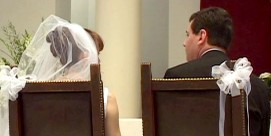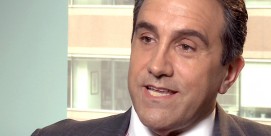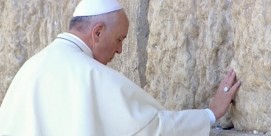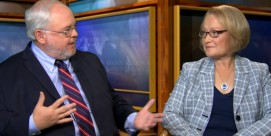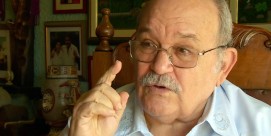In This Episode << SLIDE LEFT TO SEE ADDITIONAL SEGMENTS
Peter Steinfels Extended Interview
Read more of Bob Abernethy’s interview with Peter Steinfels about his book A PEOPLE ADRIFT: THE CRISIS OF THE ROMAN CATHOLIC CHURCH IN AMERICA (Simon & Schuster):
Q: What does it mean to be a Catholic from Chicago?
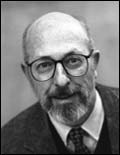
A: I think Chicago Catholicism had a particular open quality. I have a feeling, now that I’ve lived a mere 40 years in New York, that East Coast Catholicism was a little bit more embattled, because the waves of Catholic immigrants landed here and often ran into opposition. There was a more relaxed quality in Chicago and a willingness to let groups experiment and try out new things. Many of the Catholic action movements in the country ended up with their headquarters in Chicago.
Q: What was the effect on you that your father was a church artist, painting murals for Catholic churches?
A: Well, I think the effect, first of all, was that one recognized that one’s faith was not a Sunday thing. It was something that had to do with what you did, I’d say, 40 hours a week, maybe 60 hours a week. Sometimes we became, as kids, directly involved in helping out with little aspects of the job, whether it was sanding wood panels for the Stations of the Cross that would go up in churches, or other aspects of his work.
Q: You were an altar boy.
A: I was, of course, an altar boy, yes.
Q: Why do you say “of course”?
A: I don’t know. It just seems such a natural thing that so many people my age were. I was a relatively pious kid, I suppose.
Q: You’re a lifelong Catholic, a historian, a reporter, editor. Was it a problem at all fitting together your love for the Church with your responsibilities as a scholar and a reporter?
A: I was always convinced — and maybe naively so — that telling the truth about things, whether they made the Church look good or sometimes cast a less favorable impression of it, was the best thing for the Church and, in the long run, that would serve the Church.
Q: Could you state the alternatives that the Church faces, the alternatives you present on page one, right at the top of your book?
A: I think the Church faces the prospect of a very serious decline or a thoroughgoing transformation. I don’t mean a decline so much in numbers. I mean a decline in the way that the faith of Catholics may be hollowed out so it no longer means as much to them, and it no longer affects the central decisions that they make in their lives.
Q: You call this situation a crisis.
A: I do think it’s a crisis in the sense that the Church has 10, 12, 15 years to make some very major choices about important issues that are facing it now.
Q: And if it doesn’t, then what?
A: I think we might see what I call a “soft slide” into a kind of nominal Catholicism. There are two big developments going on within the Church: the decline in the number of priests — and sisters and nuns, as well — who have constituted the middle management of Catholicism, from the parish right up to running major Catholic institutions. That’s one challenge, and that could affect even the availability of Mass and the Eucharist in many parishes.
The other big change is generational — that we’re passing from a leadership made up of Catholics who were formed in a highly defined, often ethnically rooted Catholicism before the Second Vatican Council in the 1960s, to Catholics now in their forties who were often coming of age in a period of Catholicism that was changing very rapidly and was often rather uncertain.
Q: Why should Americans who are not Catholic care about what happens to the Catholic Church in the United States?
A: I think anyone recognizes that this is the largest single religious body in the country; that about a quarter of the population call themselves Catholic in one sense or another; and that the Church has created an enormous network of parishes, schools, health care facilities, social services, colleges, and universities — many of which serve as anchors for neighborhoods and communities, and so they have a very important role in our society.
Q: What are some of the facts, the data, that to you are most telling and revealing about what’s going on?
A: One of the chief facts that we can point to is the ratio of priests to people. There was one priest for about 650 Catholics in 1950. Today, there may be one priest for, perhaps, 1,400 or more Catholics in the country. That’s an important figure.
A[nother] crucial fact is that there are about 27,000 active diocesan priests in parishes. At the same time, there are now 30,000 lay pastoral ministers. These are people who work part-time or full-time professionally, doing the kinds of things that priests, sisters, and nuns used to do. Eighty percent of them are women. Over two thirds of them are working full-time. This is a very positive change in one way. It’s the shift from a clerical leadership to a leadership by laity. But it’s something that the Church has to learn to deal with from here on in.
Q: You write that one of the things that concerns you so much is the “polarization” of the Church that’s taken place — liberals on the one hand, conservatives on the other. It is very difficult for them to meet on common ground. Why is it so vicious?
A: I think you have to go back to the landmark event of the early 1960s, the Second Vatican Council. This was probably the most important event in Roman Catholicism in centuries. Various camps emerged from the debates at that council about changes in the way the Mass was celebrated, changes in understanding of Church practices. Over time, those camps became increasing hardened, if you will, and suspicious of one another. Today, any initiative for change is looked upon by one side or the other as somehow threatening basic things about the Church. The liberals see an initiative from the conservatives as somehow constituting a betrayal of the Second Vatican Council. Conservatives tend to look at any initiative from the liberals as somehow constituting a betrayal of one of the fundamental teachings of the Church.
I’m hoping that somehow the Church can get over this polarization and take a much more practical and pastoral and even empirical view of issues, like the quality of Sunday worship; whether religious education is effective or not; what is going to be the future of the priesthood; and so on.
Q: I am interested in your special take on the sex abuse scandal of 2002 — that its roots go far back and that, for one reason or another, it seemed to some people like a new thing when it really wasn’t.
A: I was surprised at the beginning of 2002 by how shocked many people, including Catholics, were. It was shocking news but, in a sense, it wasn’t surprising, because the Church had seen a wave of revelations about sexual abuse of minors by priests from the late 1980s to the early 1990s.
I think to understand this question we have to look at it in different phases. We have to see the period of time before 1985, when the hierarchy just didn’t understand the seriousness of this problem at all. We have to look at the period from 1985 to the early nineties, when they began to come to grips with it, but did so all too slowly. We have to see the period from the early nineties, when they began to take some actions, but never succeeded in following up or arriving at an obligatory policy the way they did, finally, at the Dallas meeting in 2002.
Q: You come down very hard on the bishops for not addressing it more quickly, more thoroughly.
A: I do think there was a real failure of decisiveness and follow-through. And all along the line there was a failure of openness with the Catholic people and with the public at large about the things they had failed to do, but even about the things they really had done.
Q: The crisis is far deeper than the sex abuse scandal. You describe other major forces and events that caused it.
A: There are two things that have gone on within the Church — the decline in the number of priests and nuns and the generational change — [that] the leadership of the Church now has to negotiate its way through. But there are two other things outside the Church. One is a massive, historical change in our understanding of human sexuality. The other is a global change in the way we understand the equality and dignity of women and women’s roles in all aspects of life. Those are two things that the Church has got to grapple with in the next 10 to 12 years.
Q: What about the sixties, the attitudes that grew out of the protests of the sixties, and what about secularism, generally?
A: It’s very important to realize that certain changes would have taken place in American Catholicism, regardless. The GI Bill changed the educational level of American Catholics. The move to suburbia broke up old ethnic and highly Catholic communities in the inner city.
But in the sixties, you had this landmark event, [the] Second Vatican Council, that changed so much in Catholicism at the same time as you had this decade of protest, of challenge to authority of all sorts — civil as well as religious. Those things came together in a way that made for dramatic turmoil within the Catholic Church.
It’s hard to tell with secularism what is cause and what is effect, but certainly the fact that Catholics had arrived in the mainstream of American society and now had accomplishments in their professional lives, in their business lives, and so on, that would make the religious community less important than it was as a community of survival for many immigrants — that certainly contributed to the attractiveness or the force of secularism.
Q: And out of all these forces, what were the major results within the Church?
A: There were three changes, at least, that you can point to. One, coming out of the Second Vatican Council, had to do with the relationship between the Church and the rest of the world as well as, of course, other Christian and other religious groups. From the time of the French Revolution right up through the mid-twentieth century, the Catholic Church saw itself as essentially at war with the rest of the world. It was a combative relationship. The Second Vatican Council really took the posture that the Church is in dialogue with the rest of the world. We can learn as well as teach. That had a major psychological effect throughout all of Catholicism.
The second thing that happened was the egalitarianism, if you will, within the Church, because the Council made it clear that it was the baptismal calling of all Catholics that was so critical, and not simply the distinction between the laity and the ordained. Even at the Mass the breakdown, the distinction between the priest and the people grew less and less.
The third thing that I think you could point to — and this fell in line with a lot of other events in the 1960s — was the great debate over contraception that went on from the mid-sixties right up to the encyclical by Paul VI, Humanae Vitae. This resulted ultimately in a real shaking of teaching authority on the part of Church leaders, because so many Catholics found themselves unable to agree with the continuing ban on contraception.
Q: I want to ask you about changes in belief. There were some fundamental shifts in what people thought about the Eucharist, about confession.
A: The fundamental tenets of the Church remained unchanged, but there was a different register in which things were played out. The communal dimension of the Sunday worship became much clearer, so it was the entire community gathered together to celebrate the Eucharist, less so than the simply “God and me” relationship that had been very characteristic in the past. There was a new emphasis on the Church’s witness and role in this world, and less emphasis on what would happen to one’s soul after one died.
The subject of what happened to the sacrament of confession is a mystery. Catholics voted with their feet. They stopped availing themselves of this sacrament to a large extent. And nobody, in fact, called for that. No one has satisfactorily explained that to this day.
Q: What happened to the explanation of the Eucharist?
A: For some years now, Church leaders have been concerned that Catholics were losing their traditional conviction that at mass the bread and wine were changed truly into the body and blood and the presence of Jesus. I think there’s evidence that that [shift] was taking place, and it may have had to do with a greater sense that Jesus was also present in the gathered assembly for worship. But I do have to say that within the last few years, there’s been a reemphasis on the traditional teaching, and probably the belief has swung back again.
Q: As you sit in church and look around and listen, what are the signs of the changes since Vatican II?
A: Oh, at worship, the signs of changes are immense: the very fact that the priest is facing the people from the other side of the altar; that the Mass is said in English or in whatever vernacular language — in my own parish, many of the masses [are] in Spanish; that the congregation is participating much more fully, both in responding to the priest and in song. [This] gives an entirely new sense that we are together, celebrating this mass. We are together offering up this thanksgiving, this Eucharist, to God.
Q: But you’re also pretty critical of what happens in too many average parishes at Mass.
A: I’ve argued that the future of the Catholic Church is probably more likely to be determined by the quality of worship on Sunday than what happens in Catholics’ bedrooms, which is the impression one gets sometimes from the news media. I think the issue really is quality. For decades now, there have been debates among Catholics about the liturgy, about the translations of the prayers from Latin, about the kind of music that is sung.
But all too often, these debates have gone on at a very high and often fierce theological level, and there has been too little attention to what actually happens out in the congregation. What is the sense out there? How many people are actually singing? How many people actually understand their role in the Mass? I hope I can make a case for more of this practical, pastoral and, again, I’d even say empirical examination of the quality of our worship.
Q: Once, if a Catholic did not go to mass on the weekend, that was a serious problem. It put his soul at risk. How did that change?
A: That’s a change that is, again, a bit hard to explain. There is a real diminished sense of the danger of damnation among Catholics. I think there is a sense that, perhaps, there was altogether too much stress on the danger of damnation among Catholics, and that it was a very negative, critical view of God and God’s love.
On the other hand, as Bishop Kenneth Untener of Saginaw, Michigan, has said, “We once had two choices. We either went to Mass on Sunday or we went to Hell. Most of us chose Mass.” The fact that that is different really does go a long way to explain the declining numbers of people at Mass on Sunday.
Q: How do you think the celebration of Sunday Mass should be changed?
A: I don’t really think we need to have another round of significant changes. We have to do what in athletics is called “execution.” We have to celebrate the Mass as it’s now set out, but we have to do it well. We have to do it attentively. We have to pay attention to whether we’re succeeding or not. Other people would say the term we need is “craftsmanship.” I think that’s the direction we have to go in.
Q: The papal encyclical in 1968, Humanae Vitae, had been described as the “Vietnam War” of the Church. Talk about the consequences of that.
A: The comparison between Humanae Vitae and the Vietnam [War] … really amounts to this: that we continued for a long time fighting the war in Vietnam because we felt that if we didn’t, the nation’s credibility would be destroyed. What we found out was that by continuing to fight there over such a long time, the nation’s credibility was, in fact, undermined; credibility, in fact, was strengthened when we ceased that effort.
Similarly, in the case of Humanae Vitae, there was a feeling that Church authority would be seriously undermined if the Church reversed in any way its teaching about contraception. But, in fact, by maintaining the same, total, absolute prohibition, that very thing happened. The authority of the Church was, indeed, undermined when Catholics found themselves unable to bring together their own experience of marriage with the teaching as it was declared in the encyclical.
Q: And did that then spill over into attitudes about all kinds of other things coming from the Vatican?
A: It certainly spilled over into all kinds of other teachings that touched on sexuality in any way and, ultimately, I think, in general to other teachings, so that there are a lot of Catholics who, unfortunately, don’t really even grapple with the serious teachings of the Church. They make up their minds in an all too casual manner.
Q: One of the major problems you point out is the difficulty of the hierarchy in dealing with the growing sense of equality of women.
A: In recent years, the Church has affirmed in stronger and stronger terms the equality of men and women. At the same time, the traditional refusal to ordain women to the priesthood has created a conflict with the teaching of equality. The truth is that, unless women can be put into visible ritual roles and have a real decision-making role within the Catholic Church, this conflict is just going to be something that really undermines the Church’s credibility.
Q: Do you expect to see the ordination of women as priests?
A: For me, personally, the arguments — and they are serious arguments — against ordaining women to the priesthood are not persuasive. I would say that the Church should simply go step by step. There are a lot of steps the Church could and should take to demonstrate that it is really committed to the equality of women. I would argue that the Church should ordain women to the deaconate, for example, which is a step, and see if that, indeed, does convince people that there is consistency between the Church’s teaching on the equality of men and women and its internal life. If women were ordained as deacons, it would make it much easier for women to be, in fact, named as cardinals. And women could be named, therefore, as part of the group that elected each pope.
I grew up in a family that always wanted to have the Mass said in English instead of Latin. I never expected to see that. I did see it. So when it comes to the question of the ordination of women, I don’t know. I may see it.
Q: You are, in many ways and many times through your book, deeply critical of the U.S. bishops. Your sharpest words probably come with respect to them. What did they do, or not do, that you see as so damaging?
A: It’s a mistake to think of the bishops as having been bad leaders. The problem is that there’s been a vacuum of leadership; again and again, they have tended to look over their shoulders toward Rome and the Vatican, rather than look right in front of their faces to what was happening in the Church. There are too many problems that they put off dealing with. The sex abuse scandals could be one example of that; their reluctance to deal, except by exhortation, with the problem of the declining number of priests is another striking example.
Q: John Paul II appointed most of the American bishops now. To what extent do you blame him for putting their loyalty to the Vatican so high among the priorities?
A: I think that the pope has wanted to appoint people who were both loyal to the Vatican and who were dynamic and risk takers in their own approach to leading the Church. Unfortunately, again and again, he’s not had all those qualities before him in individuals, and loyalty has been the one which has been the highest priority, so that other leadership qualities — such as willingness to take risks, being farsighted, being capable of communicating one’s views in a public forum — have gone, to a considerable extent, by the wayside.
Q: Is it possible that someday bishops in the American Church could be elected, rather than appointed?
A: The Church throughout the world has to examine the highly centralized nature of selecting bishops, and I think there are real revisions that could be made that would widen the participation, even of the other bishops as well as of the local clergy and laity, in their choice. The idea of an out-and-out election is pretty far-fetched, but there could be revisions.
Q: What are the most important changes the Church should make now to deal with these problems?
A: The biggest single change is to overcome the polarization on theological issues and to take a much more pastoral and practical approach. I think that the bishops really have to look at the reality of the Catholic Church in the pews, in the parishes. But the laity also has to take responsibility for maintaining Catholic identity and continuity, which in the past was something they could give up to their clergy and bishops.
Q: What could be done to bring about what you call “thoroughgoing transformation” in the Church?
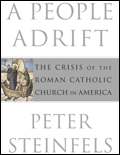
A: The bishops could open a serious discussion about allowing married men to be ordained to the priesthood, about at least opening the deaconate to women. They need to put an important, new priority on the quality of Sunday worship. They need to take religious education seriously, particularly religious education of adult Catholics, which has never been sufficiently emphasized within American Catholicism.
The laity has to take new responsibility for the institutions, such as Catholic social services, health care, hospitals, and higher education, that they are now leading. They have to take responsibility for maintaining the Catholic character and identity of these institutions. And I think it would be a good thing, generally, if the pool of parish workers and priests could be enlarged so that we not only think about maintaining quantity, but real quality in those ranks.
Q: If there were a change in the celibacy requirement for male priests, perhaps there would be a lot more priests?
A: When it comes to the debate about celibacy, I think it’s important to recognize that the problem is not, as it’s often been, with celibacy. The situation today is that the Church, from the pope on down, has given a new emphasis to the value of marriage — family and human sexuality as a way to genuine holiness. No one’s going back on that, and therefore many people who would be drawn to the priesthood are equally drawn to this other calling of marriage and the family.
Many Catholics still hope that the numbers of priests and those seeking the priesthood can be enlarged. My view is that the decline is probably irreversible. It’s not because of problems with celibacy, which is a practice well rooted in Catholic tradition. The real reason is that, in fact, everyone from the pope on down has given a new recognition of marriage and family as genuine ways to holiness. As long as that’s the case, there are not going to be those numbers who were drawn to a celibate lifestyle, which was always given a very high priority, whereas marriage and family life and sexuality were treated as second best; they were for the “Grade C” Catholic in terms of holiness. In that sense, we really are not going to be able to change the numbers within the priesthood unless we do recognize the possibility of married priests.
Q: Another prescription for the Church from some people is that if priests were just faithful to their vows, to the teachings of the Church, then all these problems would be solved. What’s your response to that?
A: I certainly am in favor of fidelity, of faithfulness to the Church’s mission and teaching. What that approach doesn’t recognize is there are tensions within that teaching. There is the desire to recognize, for example, as the pope himself would say, the value of human sexuality; and yet, there is the teaching that many people find in contradiction to that. There is the desire to be faithful to the Church’s teaching on the equality of women and yet, a tension, as it seems, with the Church’s practice in regard to the roles of women. It isn’t as simple as fidelity versus infidelity. It’s a question of how you exercise your fidelity within the whole array of Catholic teachings.
Q: The U.S. bishops are as they are. The Vatican is as it is. Younger seminarians are said to be very conservative. What do you think the chances are, realistically, of achieving the kinds of changes that you recommend?
A: Well, first of all, I think there are a lot of hopeful things going on. One of the difficulties in writing a book about 65 to 70 million Americans is that there are such differences. There are spots of mediocrity; there are places of tremendous vitality. And there are whole developments, such as the emergence of some 30,000 lay pastoral ministers, that are remarkable and quite promising.
I hope that laypeople can take a lot of initiative on their own without waiting for leadership from the clergy, from bishops, even from Rome. I also think that a lot of the clergy and the bishops, when faced with the perils of pastoral stagnation or pastoral avoidance of these issues, will just act, perhaps inspired by the Holy Spirit, the way people often have acted in the past. They change their approach when necessary.
Then there’s a possibility that, if we were well prepared for another papacy that might give more leeway to local leaderships in different countries and different conferences, the bishops around the world [and] the Church in the United States could take advantage of that situation.
Q: You think that the Church in the U.S. might be strengthened if it could be more independent of Rome?
A: I hesitate to use the words “independent of Rome,” because the connection, the sense of a global Church, the sense of our responsibility to other nations is something very special about Catholicism. On the other hand, I think there’s a general feeling — and this is a feeling among conservatives as well as liberals — that perhaps centralization has gone too far, and there has to be more room for local adjustment around the world by Church leaders.
Q: Other churches have been buffeted by the same cultural forces that have buffeted the Catholic Church — Evangelical Protestants, Mormons — and they seem to have come through it without having the same problems. Why has the Catholic Church been hit so hard?
A: Well, I wouldn’t want to underestimate the very, very positive things that have happened in the Catholic Church — where it has become a voice for social justice, where it is a church that represents both the outsiders in society and many of those who are well established in the mainstream.
I wouldn’t want to put myself in the position of exaggerating how hard hit the Church has been. It is, after all, a church which is still growing in numbers, and it exerts a tremendous presence in American life.
At the same time, we see peril down the road. Whether there’s peril down the road for [others], I don’t know. But I think your question turns us to something very basic in the discussion of what makes churches vital or not. And that is, is it better to be sharply defined over and against your society, or is it better to accommodate the social changes that are going on?
I think the notion that it is important to have a clearly defined identity and not to be accommodating simply for the sake of accommodation is fundamentally true. The Catholic Church needs to recognize that, and I would certainly argue for the maintenance of a firm Catholic identity.
But I also think that it’s wrong to ignore the fact that other religious groups, like the Evangelicals and the Mormons, have adapted in many, many significant ways to changes in American society. You don’t hear Evangelicals saying the same things about gambling, dancing, women working at home, even divorce and remarriage, that you might have 30 or 35 years ago. And even the Mormons have changed considerably, in terms of social changes.
Q: It’s been said that, from the perspective of the Vatican, the pope might think that it was in the best interests of the worldwide Church not to make changes that would, perhaps, be in the best interest of the Church in the United States, and he might be willing to take some losses in the United States in order to prevent them in the rest of the world. What do you make of that?
A: I think it’s very hard now to be a good pope for all the regions of the world, with their different cultures, the different phases they are at in terms of economic life, industrialization. So it would be possible for Rome to think that it’s better for the Church overall, and that there may, in fact, be limitations on what we do, or can do, because of the needs of the Church elsewhere. But I also think it’s important for us to make our own case and to point out that, in many ways, a lot of the rest of the world will, with time, be facing the same problems that we’re facing in the United States.
Q: Would you see different churches and different regions of the world, in different phases of development, being able to have roles that would be somewhat different from those in other places?
A: I think that there is some possibility for this. I mean, we already have within the Catholic Church, for example, branches of the Church which have a married priesthood. We have within the Catholic Church those churches rooted in Eastern Europe or in the Middle East that have a married priesthood, as well as those in the Latin rite who have a priesthood that is celibate. There’s a lot more room for variation, perhaps, than we recognize.
But it’s also true that certain questions, like those about women, really are global questions. Even if the pace of change may not be the same in different parts of the world, the direction of change seems to be clear.
Q: What do you make of some people who see that the problem is essentially a crisis of a male-dominated, traditional Vatican versus a modern America?
A: I think putting this issue in terms of old-fashioned Vatican versus modern America is a little too simple. I’m uncomfortable with that, because I think that takes American society too easily as the one standard that the Church has to adjust to. I would insist much more that the tensions are within the Church. There are tensions within the Vatican; there are tensions within the American Church. They’re not just America versus Rome.
I wrote this book out of a concern as a Catholic that, over the long run, the Church in the United States might follow the same route as the Church in a lot of Western Europe, where it became part of a smaller and smaller minority within the population, where its public influence was less and less. I think I also wrote it out of a concern as an American citizen that this major American institution, that not only served many parts of the country but was the moral and spiritual glue for so many Americans, might decline.
Somehow or other, when I look at the particular issues that the Church faces, I can get rather discouraged about the possibility of there being a sufficient response. And then when I go around to many, many parishes, many Catholic agencies, when I talk to young Catholic students who desire to work within parishes or pursue that kind of pastoral ministry, I think that somehow these problems will actually take care of themselves, and we will somehow successfully struggle through.
Q: But you make it very clear in your book that you’re calling for dramatic strengthening of leadership in the Catholic Church.
A: Leadership is the issue. I actually chose the title of the book, A PEOPLE ADRIFT, in 1997 — years before the headlines were full of the news about sexual abuse and the failures of bishops. All along I was concerned about whether the leadership would be there.
I want that leadership. What I’m concerned about is that people not just wait upon the bishops, or wait upon a new pope or a change in the Vatican; there’s a lot that can be done by laypeople independently. There’s a lot as far as the quality of Sunday worship, for example, that can be done by clergy right now. There’s a lot that can be done in terms of adult and other religious education, by the pastoral ministers that have emerged. There’s a lot that can be done without any conflict with Rome — even quite with encouragement from Rome.
I don’t want us to wait. I am trying to encourage leadership to emerge and people to realize how serious a vacuum of leadership can be for the future of the Church.
Q: And what do you foresee if the changes you recommend do not happen?
A: There is a real danger that Catholicism could become something that people wear the way many of us wear our ethnic labels. It’s something that we identify ourselves with, but it doesn’t really shape the most central decisions of our life. And with that, I think, would come a decline in the presence of the Church in terms of services, struggles for social justice, representation of those people who are in need. In the long run, that might make the United States take a path very similar to what has happened in Western Europe, which is a much more extensive secularization of society.
If we compare Catholics who were born before 1943 with Catholics who were born after 1961, we find out that 37 percent of those in the earlier generation said that the most important thing in their life was their faith. Among the younger generation, it’s down to 14 percent who say their faith is the most important thing in their life. At the same time, the percentage of those who say that their faith is not too important at all has gone from something like 22 percent in the older group to over 40 percent in the younger group.
I think that illustrates the danger of the hollowing out — that the faith will not truly affect how one lives in one’s daily life, how one makes important decisions about marriage and family and what you do in your career and how you deal with your children and the next generation, and whether you forgive one another and how you live and sense your responsibilities. That is, I think, the danger the Church can face.
One other thing that’s very important about American Catholicism is that it is a “bridge” institution. It bridges different parts of the nation; it’s not like the Southern Baptists, located largely in one region. It bridges different classes. It bridges Republicans and Democrats. It bridges people who have now made it into the mainstream, who are well represented on Wall Street and in the halls of Congress, and the newest immigrant groups, whether from Latin America or Asia. That’s another thing that makes it very important to this society.
Q: Have you had any comment that you could pass on from any Catholic bishops?
A: I’ve received a few personal notes from Catholic bishops thanking me for the book. I suspect they may not be representative of the hierarchy as a whole, but one of the things about Catholic bishops is that they are people who play their cards very close to their chests. So I don’t really know.

